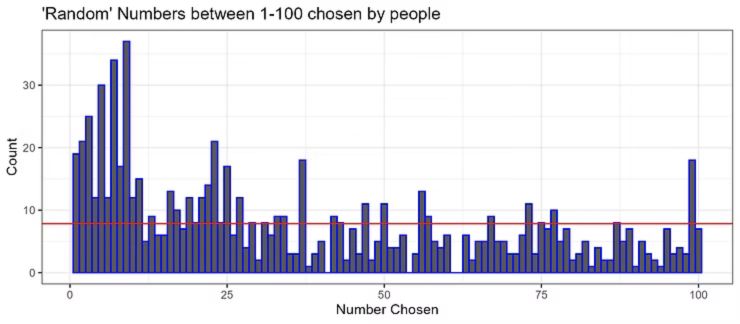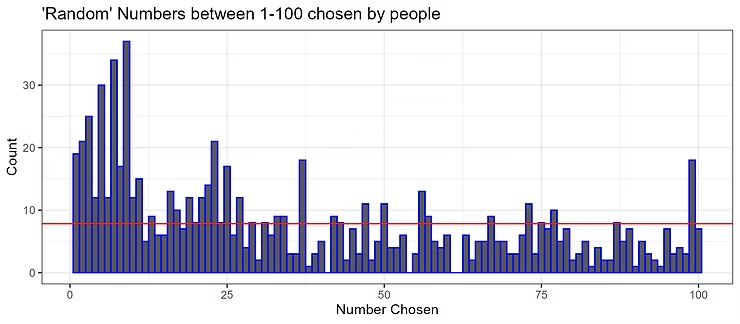Patterns I Predicted:
Here are the patterns I expected people would show:
- Choosing more odd numbers than even numbers.
- Picking prime numbers more frequently.
- Avoiding multiples of 10, because they feel less “random.”
- Rarely choosing numbers like 1 and 100.
What Did We Actually Find?
In theory, odd numbers should be chosen half the time (around 392 times). Instead, people chose odd numbers 485 times—that’s about 62%! If you look closely, you can see the graph’s jagged “sawtooth” pattern showing how even numbers are neglected.
Multiples of 10 Lose Out!
Multiples of 10 should make up about 10% (78.4 times), but they were chosen only 57 times, about 7%. Clearly, numbers like 10, 20, and 50 don’t feel random enough!
Prime Numbers Are Popular!
There are 25 prime numbers between 1 and 100, meaning we’d expect about 25% of the choices (196 times). Surprisingly, primes were chosen 282 times—that’s 36%!
Favourite Numbers Emerge
Some prime numbers were especially popular:
- 7 was chosen 34 times
- 23 was chosen 21 times
- 37 was chosen 18 times
where any single number should only be chosen 8 times if it were truly random.
But even if we remove these favorites, the other primes were still chosen 209 times, much more than we’d expect. Clearly, people feel primes are more “random.”
Two curious pattern emerged when looking at pairs of numbers.
People choose numbers in increasing order
If truly random, the second number chosen would be bigger about half the time. Instead, 64% of people chose the second number to be larger than the first!
People choose numbers from 1-10
Only about 4 people (1% of all responses) should have chosen both numbers between 1 – 10. However, we find 50 people (that is, 12.7%, or one-eighth of all respondents) chose both numbers to be less than 10.
So, How Random Were Your Numbers?
Now, look back at your numbers. Did you pick an odd or prime number? Was your second number larger than the first? Or maybe you avoided multiples of 10 without realizing it?
It turns out humans aren’t great at being random—we’re influenced by what we believe “feels random.” Next time someone asks you to choose a random number, direct them to an actual random number generator, and show them this blog as your justification.
Remember, we can’t judge how random someone’s choice is based on just one or two examples. Real patterns only become clear when we look at many responses—hundreds or even thousands, as we’ve done here! So don’t immediately accuse your friend of being biased if they choose 7 as a random number. Instead, gently remind them that large studies (like this one) show clear patterns in how people think about randomness. After all, if no one ever chose 7, wouldn’t that be a strange kind of bias, too?
This casual experiment ended up being a very pleasant rabbit hole that I went down! There’s also a lot of research around this, which I will bring together in a subsequent blog. Watch this space! Click ‘Log In’ in the top left corner and create a free member account to be notified about future blogs.
If you have any questions or comments, feel free to post it here! I am looking forward to a lively discussion!
If this kind of math and learning excites you, I’m hosting a free online
masterclass this Saturday (April 5th) called: Math That Breaks the Internet. We’ll explore the math of going viral — from exponential growth to social media spread to population booms. Please do share it with curious people aged 9 and above


